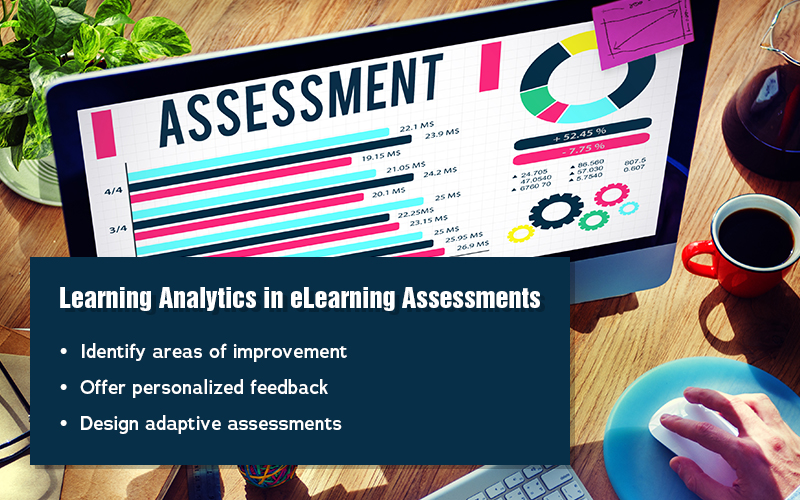How Learning Analytics are Influential to Enhance Rapid eLearning Courses
To understand the preferences of the modern learners, there is a crucial need for learning analytics or else the rapid eLearning courses might not turn out to be engaging and productive. Explore the Importance of learning analytics below.

Organizations prefer rapid eLearning to design eLearning courses for their global workforce because of the quick development and delivery time. Sometimes it gets complicated to understand the effectiveness of the courses and measure their impact. Learning analytics helps organizations understand the various aspects their courses need enhancements on and provide actionable insights for the preferred metrics. By utilizing the learning analytics properly organizations can seamlessly figure out the learning preferences of their workforce and enhance the quality of rapid eLearning courses accordingly.
Are Your Rapid eLearning Courses Not Providing The Desired Results?
Utilize these benefits of learning analytics to enhance your training:
- Helps Analyze and Enhance Employee Performance
- Provides Actionable Insights to Design Personalized Learning
- Plays a Vital Role in Improving Employee Retention
- Saves Time and Money
What Are The 4 Distinct Types of Learning Analytics?
1. Descriptive Analytics
This is the first level of learning analytics that is used to get the answers about certain issues like what exactly happened or what is the actual cause of the problem. Basically, descriptive analytics is all about numbers like how many employees enrolled for the course, what were their scores, how many passed the course, how many dropped out, etc. This is useful to enhance the courses for the future because it allows the organization to track past performances and study those numbers to create personalized rapid eLearning courses efficiently.
2. Diagnostic Analytics
If the first one was about knowing the answers, this one is to help you ask different questions about what made something happen or why something didn’t work out. To explain diagnostic analytics, let’s consider an example of a single sales training course rolled out for newly hired employees as well as existing employees. The post-course diagnostic report shows that the newly hired employees found it interesting, engaging, and productive while the existing employees including seniors found it very basic and repetitive, hence an increased dropout rate.
This report will help the organization to develop different courses for the newly hired and existing employees and enhance the learning experience for both of them.
3. Predictive Analytics
A crucial advantage of learning analytics is that the progression report to present helps the organizations predict the future to a certain extent. The accuracy differs on the amount of data and information present, but this estimation still helps the organization to make early changes to their course, before it’s too late. For example, an eLearning course didn’t have enough assessments or they weren’t interactive and engaging enough, so the learners were not able to retain the knowledge they gained. The courses were also not available on mobile due to certain technological limitations.
A predictive analytics report can successfully figure out the problems, and now the organization can come up with respective solutions. The courses can be updated accordingly with the help of modern rapid authoring tools like adding gamified interactive assessments and creating certain microlearning modules out of the courses to be accessed on mobiles anywhere.
4. Prescriptive Analytics
This is just an addition to predictive analytics, to help the organizations to understand what will be the right move for the current problem causing disruptions in training. Organizations gain insights about why something will happen and take suitable measures to handle it. Reviews and feedback highly impact the reports of such kind, like a simple survey can help the organizations understand what is lacking in the course, and make the desired changes before rolling out the course within the organization.
Eager to know more about learning analytics? Check this.
The Importance of Learning Analytics to Enhance Rapid eLearning Courses
1. Helps Analyze and Enhance Employee Performance
When an employee is completing a certain course, their daily progression is recorded and it can be accessed by the trainers and L&D managers to understand their pace and hurdles. These analytics can predict the performance for an upcoming period by monitoring the data recorded till the time of access, assisting the trainers to understand where the employee needs help and which portion he can excel all without support. If the managers spot an issue in the analytics report of an employee, they can use that data to figure out a possible solution like providing external resources or adding mid-course eLearning assessments for knowledge retention, etc.
2. Provides Actionable Insights to Design Personalized Learning
Modern workforce doesn’t work around the concept of ‘ one size fits all ’ narrative, so a monotonous eLearning course won’t effectively engage them. Learning analytics can help you understand the preferences of learners and develop rapid eLearning courses quickly based on the collected data. If the organization is aware of what interests their employees the most, they can decide the instructional design for their future courses and improve the learning experience of their employees.
For example, 20% of learners prefer text-based courses, 35% of learners prefer video lectures, and 45% of learners prefer gamified assessments and interactions throughout the course. Apart from this, 70% of learners prefer to access their training on mobile phones while the rest 30% prefer laptops. To meet the requirements of the employees based on this data, the organization might come up with a VILT program and prefer a mobile-friendly platform to conduct the sessions. The external supplementary learning resources can be provided in the form of PDFs to fulfill the choices of learners who wanted text-based courses, and this way everyone will have something for them.
3. Plays a Vital Role in Improving Employee Retention
Employees tend to leave the course midway if they aren’t able to grasp the information relayed to them through their eLearning courses. This makes them less productive at their job eventually causing them to drop out of the company. To prevent this from happening, organizations can use the learning analytics report to analyze what parts of the course are the cause of disruptions for the learners and make considerable changes or provide external support to keep the employees motivated for training. This will help the learners to complete the course and decrease the dropout rate of employees improving the overall employee retention for the organization.
4. Saves Time and Money
Due to the previous benefits we just discussed, it’s quite self-explanatory how effectively using the learning analytics report can help the organization create custom rapid eLearning courses for their employees. When instructional designers and developers know what exactly to create, they won’t waste their time brainstorming different approaches. And when you have a clear idea of where to invest your resources, it will save your budget from getting wasted on other irrelevant things. Thus, a detailed and accurate learning analytics report can save a considerable amount of time and money for the organizations and improve the overall training ROI.
Parting Thoughts!
The whole corporate world runs on data and numbers, and the eLearning industry is no different. This data provided by the learning analytics report helps the L&D teams and the respective stakeholders figure out what’s best for them, and what sort of changes are preferred by the employees. All these reports are generated mainly by an LMS and the choice of your LMS can really affect the health of your rapid eLearning courses and the eLearning experience of your employees. To help you out, here’s a free eBook to gain insights about how to choose the perfect LMS to host your rapid eLearning courses.





